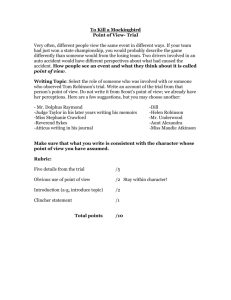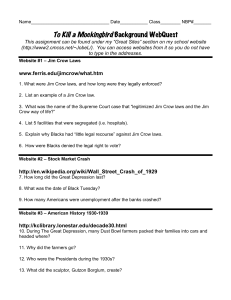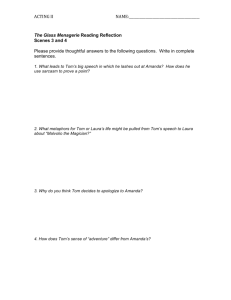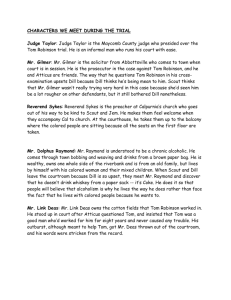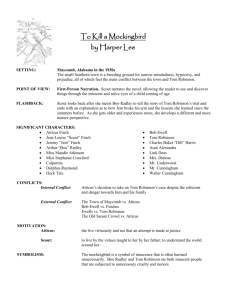Matt Wisotsky Period 4/5 Cyr LA 2-1
advertisement
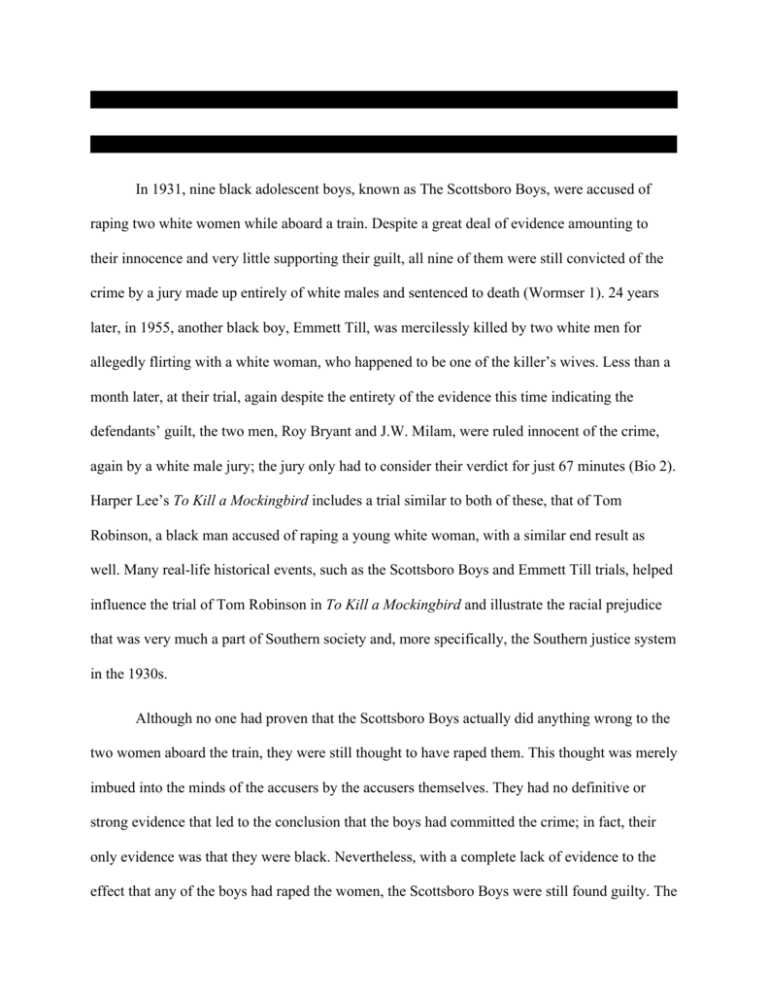
Matt Wisotsky 2-1-15 Period 4/5 Cyr LA TKAM Research Project In 1931, nine black adolescent boys, known as The Scottsboro Boys, were accused of raping two white women while aboard a train. Despite a great deal of evidence amounting to their innocence and very little supporting their guilt, all nine of them were still convicted of the crime by a jury made up entirely of white males and sentenced to death (Wormser 1). 24 years later, in 1955, another black boy, Emmett Till, was mercilessly killed by two white men for allegedly flirting with a white woman, who happened to be one of the killer’s wives. Less than a month later, at their trial, again despite the entirety of the evidence this time indicating the defendants’ guilt, the two men, Roy Bryant and J.W. Milam, were ruled innocent of the crime, again by a white male jury; the jury only had to consider their verdict for just 67 minutes (Bio 2). Harper Lee’s To Kill a Mockingbird includes a trial similar to both of these, that of Tom Robinson, a black man accused of raping a young white woman, with a similar end result as well. Many real-life historical events, such as the Scottsboro Boys and Emmett Till trials, helped influence the trial of Tom Robinson in To Kill a Mockingbird and illustrate the racial prejudice that was very much a part of Southern society and, more specifically, the Southern justice system in the 1930s. Although no one had proven that the Scottsboro Boys actually did anything wrong to the two women aboard the train, they were still thought to have raped them. This thought was merely imbued into the minds of the accusers by the accusers themselves. They had no definitive or strong evidence that led to the conclusion that the boys had committed the crime; in fact, their only evidence was that they were black. Nevertheless, with a complete lack of evidence to the effect that any of the boys had raped the women, the Scottsboro Boys were still found guilty. The jury that made this decision was, naturally, an all-white and all-male jury (Wormser 1). This element of a blind accusation is incorporated into Lee’s fictional trial of Tom Robinson. “Tom Robinson’s fictional case occurs in the midst of this actual case. The Scottsboro trials anticipate and confirm the judicial travesty that awaits and innocent Tom” (Wilson 29). In spite of Atticus’s best efforts, Tom Robinson’s verdict was inevitable, even though there was no evidence leading to the deduction of Tom’s guiltiness or supporting the fact that he raped Mayella Ewell. The jury, composed of white males, only saw fit to convict him of the crime because that was the way in which society functioned in the 1930s—a black male accused by a white woman was as good as dead as soon as the words come out of her mouth (Wilson 29). The women on the train who were the supposed ‘victims’ of the Scottsboro Boys’ crime knew that the boys had done nothing wrong and that if they agreed to testify against them they all would almost surely be found guilty and sentenced to death or life imprisonment. However, they had an ulterior motive which drove them to testify against the boys, which was fear. They were afraid that prosecutors would find out that they had took part in sexual activity with white men who were also on the train. In an attempt to cover up their own wrongdoings, they claimed the boys had committed a crime which they knew that the boys had not (Wormser 1). The actions of these women strongly correlate with those of Mayella Ewell, the accuser of Tom Robinson. While she, together with other prosecutors, charged Tom with raping her, she knew all along that he had done nothing of the sort and, in fact, she was the one who had really committed the crime. Yet she was afraid of what might happen if anyone, especially her abusive father, found out about her actions toward Tom, so this fear impelled her to testify against Tom, and as was aforementioned, “white females posed the more dangerous threat because any accusation from a white woman would result in assured death for the black male” (Wilson, Jr. 29). Prior to the Scottsboro Boys’ trial, they were attacked by a vicious mob coming to lynch them. The situation became so serious that the National Guard had to intervene in the situation and defend the boys from the lynch mob (Wormser 1). This hateful hostility and anger toward blacks and the presumed belief of white superiority demonstrated by the mob is integrated into Tom Robinson’s situation as well. A lynch mob, headed by Mr. Cunningham, came to get Tom Robinson; however Atticus, along with help from Scout, was able to step in and deter them (Wilson, Jr. 29). Nonetheless, the mob’s desperate hunger for violence is apparent in both situations, and portrays the unavoidable white ideology of black inferiority which would carry over into the trial scenarios. In the trial of Emmett Till’s murder, there was a substantial amount of evidence pointing to the guilt of the defendants, Roy Bryant and J.W. Milam. However, regardless of the evidence and facts, the jury, and even the justice system as a whole, once again sided with the whites over the blacks (Bio 2). It would not have mattered how much evidence they had, because at that time racism was very prominent, especially in southern society, and siding with the blacks if one was white would be considered treason. Tom Robinson is faced with an identical issue, although instead he is on the opposite side of it. “Even though the overwhelming evidence indicates that Tom Robinson is innocent of rape, the fact that he is a black man accused of such a crime by whites makes him guilty, regardless or reason or logic” (Wilson, Jr. 31). In this way, Bryant and Milam were protected by the justice system and its biased and unjust methods. Moreover, in just the same way, the Ewells are protected by the system and guaranteed victory in their trial against Tom Robinson. In To Kill a Mockingbird, they are notoriously untrustworthy and unrespectable people. In a case against other white people, the Ewells would stand no chance because they are seen as the lowest of the white society. However, when they are pitted against a black person, in this case Tom Robinson, then the playing field is changed and they hold the advantage. Even though they have a horrible reputation with the members of the community—which comprise the jury—they still are in better standings with them than any black person would be, at least when it comes to a trial. “When the system protects the Ewells in this instance, they continue to feel superior to blacks, and the blacks hate them even more because once again whites have benefited at the expense of blacks” (Wilson 30). Henceforth, the cycle of racism and white superiority continues and those ideas are expressed in that Tom cannot even compare to the least dignified people in the entire community simply because he is black. Furthermore, it is because of this that they are trusted during the court proceedings, even despite the fact that they are infamously known as being extremely disreputable people (Wilson 30). A famous case between nine young black boys, known as the Scottsboro Boys, and two women who had falsely and knowingly accused them of rape received a great deal of attention nationwide. This case “more than any other event in the South during the 1930s, revealed the barbarous treatment of blacks” (Wormser 1). Despite all of the evidence supporting their innocence, as well as no evidential connection between the boys and the women—who were the supposed ‘victims’ of the crime—the boys were still all convicted of the crime and almost all sentenced to execution by a biased and racist all-white jury (Wormser 1). Just over two decades later, another case came up that received attention equal to, if not more, than the Scottsboro case. This was the case of Emmett Till’s murder, a malicious and heartless crime of hate and racism. Once again, the verdict of an all-white all-male jury was influenced by racial tensions and prejudice of the time, and the clearly guilty defendants were acquitted even in the presence of substantial incriminating evidence, including a firsthand testimony from the uncle of the victim (Bio 2). These two well-known cases are very reminiscent of the Tom Robinson trial from Harper Lee’s To Kill a Mockingbird. Their themes of racial tension and hate as well as biased communities—and their influences on the verdicts—carried into the trial scene and helped to be an important factor in the transpiration of events. In final analysis, the trials of the Scottsboro Boys and Emmett Till were crucial and invaluable impacts on and inspirations for the Tom Robinson trial in To Kill a Mockingbird, and they conveyed the motif of racial prejudice that was prominent during the actual trials, as well as during both the setting of the fictional trial and the period in which it was written. Works Cited "Emmett Till Biography." Bio. A&E Television Networks, n.d. Web. 23 Jan. 2015. <http://www.biography.com/people/emmett-till-507515>. Lee, Harper. To Kill a Mockingbird. New York: Grand Central Publishing, 1960. Print. Wilson, Charles E., Jr. "Harper Lee, To Kill a Mockingbird." Race and Racism in Literature. Westport: Greenwood Press, n.d. N. pag. Print. Wormser, Richard. "The Scottsboro Case." The Rise and Fall of Jim Crow. Educational Broadcasting Corporation, 2002. Web. 23 Jan. 2015. <http://www.pbs.org/wnet/jimcrow/stories_events_scotts.html>.

